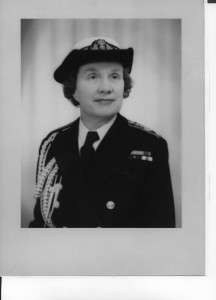Cynthia Cooke
| Cynthia Cooke CBE | |
|---|---|
 Cooke in uniform | |
| Born |
Cynthia Felicity Joan Cooke 11 June 1919 Bealings, Suffolk, England |
| Died | 20 April 2016 (aged 96) |
| Occupation | Nurse |
| Employer | Queen Alexandra's Royal Naval Nursing Service |
| Known for | Matron-in-Chief of the Queen Alexandra's Royal Naval Nursing Service |
Cynthia Felicity Joan Cooke CBE (11 June 1919 – 20 April 2016) was a British nurse who was Matron-in-Chief of the Queen Alexandra's Royal Naval Nursing Service (QARNNS), the nursing branch of the Her Majesty's Naval Service, from 1973 to 1976.[1]
Cooke was awarded the Royal Red Cross in 1964, became a Commander of the Order of St John in 1974, and a Commander of the Order of the British Empire in 1975.
Early life
Cooke was born on 11 June 1919 in Bealings, Suffolk.[2] She was the daughter of a Guardsman, and went to school at Stockwell County Secondary School in London, where a special teaching method known as the Dalton Plan had been put into place.[2]
Career and later life
In 1938, she began her medical training at Tite Street Children's Hospital, in Chelsea.[2] After war broke out, she worked as a theatre assistant, and in 1943 began her training to join the QARNNS at Royal Naval Hospital, Haslar.[2] She worked there until 1944, and before the Normandy landings she recalled cycling to the hospital past columns of Canadian tanks, to calls of "Hello sugar! Are you rationed?" from the male soldiers. By the end of 1944, she had transferred to Australia, travelling there on a troopship with 4,000 Royal Marines.[2]
In 1945, Cooke volunteered to move from her nursing post at Royal Naval Hospital, Herne Bay, in Sydney, to assist the medical team aboard HMS Formidable.[2] The ship's first mission was to collect 1,000 Australian former prisoners of war from Manila.[2] The embarkation alone took three days, and Cooke spent some of her time assisting in the creation of a body-length plaster case, complete with stretcher poles, to move a man who was suffering from spinal tuberculosis.[2]
Shortly afterwards, on 24 October, the ship sailed for Papua New Guinea to assist 1,254 Punjabi soldiers suffering from malaria and eczema.[2] Cooke warned the soldiers that the methylated spirits used to clean ulcers would hurt; her words were translated as "If doesn't hurt, it doesn't do any good." [2] Rev H Kennen DSC RNVR, who was also on Formidable, recalled her during the ship's line-crossing ceremony that she: "did fail to perform the deep and graceful traditional curtsy due, thereby insulting the First Lord of the Admiralty", and was punished "as a point of principle" with "ducking in an improvised pool".[3] After her work aboard Formidable, she transferred to HMS Queen (D19) to travel back to United Kingdom.[2]
After the war, Cooke served at RNAS Dale (HMS Goldcrest), with a young David Attenborough, who was performing National Service at the time.[2] In 1964, she was conferred with the Royal Red Cross.[2] She then served in Chatham, Hong Kong, Malta and Plymouth, before becoming the lead tutor at the Royal Navy training school in 1970, and finally becoming Matron-in-Chief of the QARNNS in 1973.[2]
In 1974, she became Commander of the Order of St John, and Commander of the Order of the British Empire in 1975.[2] She retired in 1976, and spent the rest of her life caring for her mother and supporting the Royal British Legion for Women, the National Blood Service, and her local church.[2]
References
- ↑ "Cynthia Cooke, naval nurse – obituary". Retrieved 2016-07-03.
- 1 2 3 4 5 6 7 8 9 10 11 12 13 14 15 16 "Cynthia Cooke; Naval nurse who accompanied PoWs back home after the war". The Daily Telegraph (1st national ed.). 15 June 2016. p. 29 – via LexisNexis.
- ↑ Kennen, Edwin (4 July 2016). "Cynthia Cooke; Lives remembered". The Times (1st Scotland ed.). p. 53 – via LexisNexis.